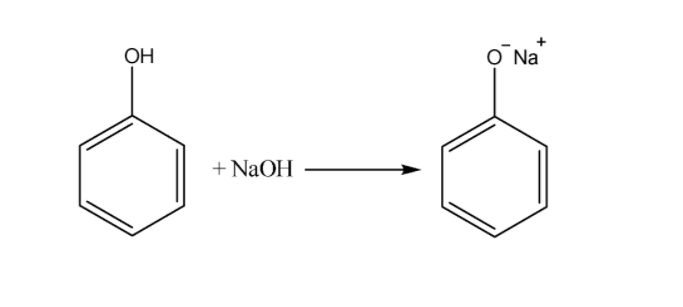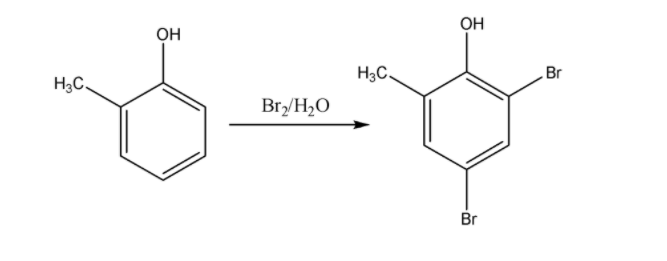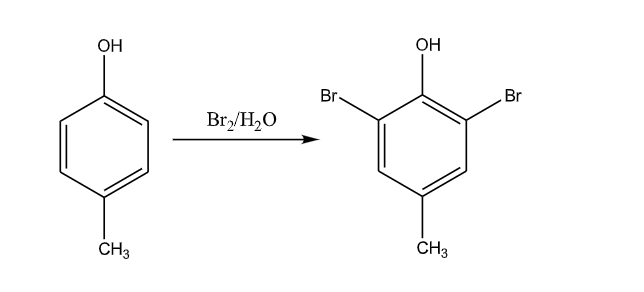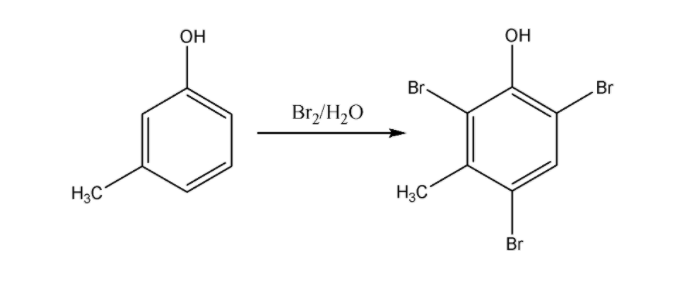Answer
36.6k+ views
Hint: We all are familiar with the fact that Benzyl alcohol is a colourless liquid with a mild pleasant aromatic odour. It is a useful solvent due to its polarity, low toxicity, and low vapor pressure.
Benzyl alcohol has moderate solubility in water \[\left( {4{\text{ }}g/100{\text{ }}mL} \right)\]and is miscible in alcohols and diethyl ether.
Again, Benzyl alcohol has a methylene \[\left( { - - CH2 - - } \right)\] group separating the phenyl ring and the anionic oxygen in the conjugate base and hence prevents resonance stabilization of the conjugate base. Hence phenol is stronger acid than benzyl alcohol and hence the latter doesn't dissolve in \[NaOH\] .
So we can conclude that since, the compound is insoluble in water and $NaHCO_3$ but dissolve in \[NaOH\] and gives characteristic colour with \[FeC{l_3}\], hence it must be phenol i.e,\[o - ,{\text{ }}p - {\text{ }}or{\text{ }}m - cresol\].
Complete step by step answer:
We can discuss this problem as following ;-
phenols are weak acids, they will react with bases. If phenol is reacted with\[NaOH{\text{ }}\left( {a{\text{ }}strong{\text{ }}base} \right)\] , it is completely converted to the phenoxide ion, which is soluble in water because it is charged. Phenol itself is not very soluble in water.
Sodium Bicarbonate is a weak base\[\left( {N{a^ + }{\text{ }}HC{O_3}^ - } \right)\]. So, it easily accepts protons when reacting with a stronger acid like a carbonic acid, but its not strong enough to pull the proton off phenol. Using a stronger base, like NaOH, it can pull the proton off the phenol.That's why phenol is not soluble in sodium bicarbonate.
Phenols show acidic nature and hence are soluble in alkalies like \[NaOH,{\text{ }}N{a_2}C{O_3}\;\]etc. The acidic nature is due to formation of resonance stabilized phenoxide ion formed by losing a proton from \[ - OH\] group.Thus more and more phenol is converted to phenoxide ion that is soluble in water.

Now it’s also known to all of you that Phenols form a complex with ferric ions. This complex has an intense colour, which may vary from blue, green or even red depending upon the nature of the phenol. Here in case of cresols we can see As an example using the chemical phenol itself:
\[6{\text{ }}PhOH{\text{ }} + {\text{ }}F{e^{3 + }}\; \to {\text{ }}{[Fe{\left( {OPh} \right)_6}]^{3-}}\]
As we know electron donating \[ - OH\]group is ortho and para directing group ; so now among all three cresols, \[o - \] cresol forms Ortho and para bromo derivatives with respect to \[ - OH\]group. So in this complex there will be two Br atoms.

Also \[p - \] cresol forms Ortho bromo derivatives with respect to the \[ - OH\]group. So in this complex there will be two Br atoms;

But in case of m-cresol we can see it forms Ortho and para bromo derivatives with respect to \[ - OH\] group. So in this complex there will be total three Br atoms;

Hence, Option 4 is correct.
Note: You should take care of choosing the correct structure because \[C7H8O\] can also give another structure like–

This structure also readily gives a precipitate of\[{C_{7}}{H_{5}}OB{r_{3\;}}\]

Benzyl alcohol has moderate solubility in water \[\left( {4{\text{ }}g/100{\text{ }}mL} \right)\]and is miscible in alcohols and diethyl ether.
Again, Benzyl alcohol has a methylene \[\left( { - - CH2 - - } \right)\] group separating the phenyl ring and the anionic oxygen in the conjugate base and hence prevents resonance stabilization of the conjugate base. Hence phenol is stronger acid than benzyl alcohol and hence the latter doesn't dissolve in \[NaOH\] .
So we can conclude that since, the compound is insoluble in water and $NaHCO_3$ but dissolve in \[NaOH\] and gives characteristic colour with \[FeC{l_3}\], hence it must be phenol i.e,\[o - ,{\text{ }}p - {\text{ }}or{\text{ }}m - cresol\].
Complete step by step answer:
We can discuss this problem as following ;-
phenols are weak acids, they will react with bases. If phenol is reacted with\[NaOH{\text{ }}\left( {a{\text{ }}strong{\text{ }}base} \right)\] , it is completely converted to the phenoxide ion, which is soluble in water because it is charged. Phenol itself is not very soluble in water.
Sodium Bicarbonate is a weak base\[\left( {N{a^ + }{\text{ }}HC{O_3}^ - } \right)\]. So, it easily accepts protons when reacting with a stronger acid like a carbonic acid, but its not strong enough to pull the proton off phenol. Using a stronger base, like NaOH, it can pull the proton off the phenol.That's why phenol is not soluble in sodium bicarbonate.
Phenols show acidic nature and hence are soluble in alkalies like \[NaOH,{\text{ }}N{a_2}C{O_3}\;\]etc. The acidic nature is due to formation of resonance stabilized phenoxide ion formed by losing a proton from \[ - OH\] group.Thus more and more phenol is converted to phenoxide ion that is soluble in water.

Now it’s also known to all of you that Phenols form a complex with ferric ions. This complex has an intense colour, which may vary from blue, green or even red depending upon the nature of the phenol. Here in case of cresols we can see As an example using the chemical phenol itself:
\[6{\text{ }}PhOH{\text{ }} + {\text{ }}F{e^{3 + }}\; \to {\text{ }}{[Fe{\left( {OPh} \right)_6}]^{3-}}\]
As we know electron donating \[ - OH\]group is ortho and para directing group ; so now among all three cresols, \[o - \] cresol forms Ortho and para bromo derivatives with respect to \[ - OH\]group. So in this complex there will be two Br atoms.

Also \[p - \] cresol forms Ortho bromo derivatives with respect to the \[ - OH\]group. So in this complex there will be two Br atoms;

But in case of m-cresol we can see it forms Ortho and para bromo derivatives with respect to \[ - OH\] group. So in this complex there will be total three Br atoms;

Hence, Option 4 is correct.
Note: You should take care of choosing the correct structure because \[C7H8O\] can also give another structure like–

This structure also readily gives a precipitate of\[{C_{7}}{H_{5}}OB{r_{3\;}}\]

Recently Updated Pages
If a wire of resistance R is stretched to double of class 12 physics JEE_Main

The path difference between two waves for constructive class 11 physics JEE_MAIN

What is the difference between solvation and hydra class 11 chemistry JEE_Main

IfFxdfrac1x2intlimits4xleft 4t22Ft rightdt then F4-class-12-maths-JEE_Main

Sodium chloride is purified by passing hydrogen chloride class 11 chemistry JEE_Main

Hydrogen readily combines with nonmetals and thus it class 12 chemistry JEE_Main

Other Pages
An electric bulb has a power of 500W Express it in class 11 physics JEE_Main

The cell in the circuit shown in the figure is ideal class 12 physics JEE_Main

Explain the construction and working of a GeigerMuller class 12 physics JEE_Main

For an electromagnet the core should have A High retentivity class 12 physics JEE_Main

Dissolving 120g of urea molwt60 in 1000g of water gave class 11 chemistry JEE_Main

Normality of 03 M phosphorus acid H3PO3 is A 05 B 06 class 11 chemistry JEE_Main




